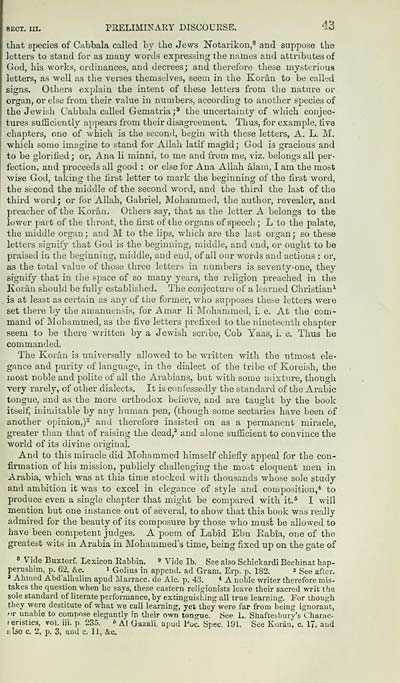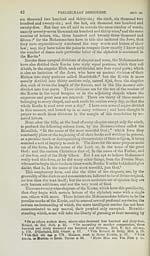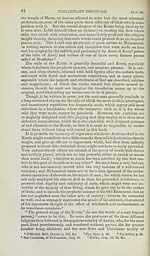Download files
Complete book:
Individual page:
Thumbnail gallery: Grid view | List view

SECT. ui. PRELIMINARY DISCOURSE. 43
that sjiecies of Cabbala called by the Jews Notarikon,^ and suppose the
letters to stand for as many words expressing the names and attributes of
God, his works, ordinances, and decrees; and therefore these mysterious
letters, as well as the verses themselves, seem in the Koran to be callod
signs. Others explain the intent of these letters from the nature or
organ, or else from their vahie in numbers, according to another species of
the Jewish Cabbala called Gematriaj* the uncertainty of which conjec-
tures sufficiently appears from their disagreement. Thus, for example, five
chapters, one of which is the second, begin with these lettei-s, A. L. M.
which some imagine to stand for Allah latif magid; God is gracious and
to be glorified; or, Ana li minni, to me and from me, viz. belongs all per-
fection, and proceeds all good : or else for Ana Allah alam, I am the most
wise God, taking the first letter to mark the beginning of the first word,
the second the middle of the second word, and the third the last of the
third word ; or for Allah, Gabriel, Mohammed, the author, revealer, and
preacher of the Koran. Others say, that as the letter A belongs to the
lower part of the throat, the first of the organs of speech ; L to the palate,
the middle oi'gan; and M to the lips, which are the last organ; so these
letters signify that God is the beginning, middle, and end, or ought to be
praised in the beginning, middle, and end, of all our words and actions : or,
as the total value of those three letters in numbers is seventy-one, they
signify that in the space of so many years, the religion preached in the
Koran should be fully established. The conjecture of a learned Christian^
is at least as certain as any of tiie former, who supposes these letters were
set there by tlie amanuensis, for Amar li Mohammed, i. e. At the com-
mand of IMohamnied, as the five letters prefixed to the nineteenth chapter
seem to be there written by a Jewish scribe, Cob Yaas, i. e. Thus he
commanded.
The Koian is universally allowed to be written with the utmost ele-
gance and purity of language, in the dialect of the tribe of Koreish, the
most noble and polite of all the Arabians, but with some mixture, though
very rarely, of other dialects. It is confessedly the standard of the Arabic
tongue, and as the more orthodox believe, and are taught by the book
itself, inimitable by any human pen, (though some sectaries have been of
another opinion,)^ and therefore insisted on as a permanent miracle,
greater than that of raising the dead,' and alone sufficient to convince the
world of its divine original.
And to this miracle did Mohammed himself chiefly appeal for the con-
firmation of his mission, publicly challenging the most eloquent men in
Arabia, which was at this time stocked with thousands whose sole study
and ambition it was to excel in elegance of style and composition,* to
produce even a single chapter that might be compared with it.* I will
mention but one instance out of several, to show that this book was really
admired for the beauty of its composure by those who must be allowed to
have been competent judges. A poem of Labid Ebn Eabia, one of the
greatest wits in Arabia iu Mohammed's time, being fixed up on the gate of
8 Vide Buxtorf. Lexicon Rabbin. » Vide lb. See also Schickardi Becbinat hap-
perushim, p. 62, &c. i Golius in append, ad Gram. Erp. p. 182. " See after.
* Ahmed Abd'alhalim apud Marracc. de Ale. p. 43. * A noble writer therefore mis-
takes the question when he says, these eastern religionists leave their sacred writ the
gole standard of literate performance, by extinguishing all true learning. For though
they were destitute of what we call learning, yet they were far from being ignorant,
'ir unable to compose elegantly in their own tongue. See L. Shaftesbury's Charac-
f eristics, vol. iii. p 235. « Al Gazali. apud Foe. Spec. lyi. See Koran, c. 17, and
i.lso c. 2, p. 3, and c. 11, &c.
that sjiecies of Cabbala called by the Jews Notarikon,^ and suppose the
letters to stand for as many words expressing the names and attributes of
God, his works, ordinances, and decrees; and therefore these mysterious
letters, as well as the verses themselves, seem in the Koran to be callod
signs. Others explain the intent of these letters from the nature or
organ, or else from their vahie in numbers, according to another species of
the Jewish Cabbala called Gematriaj* the uncertainty of which conjec-
tures sufficiently appears from their disagreement. Thus, for example, five
chapters, one of which is the second, begin with these lettei-s, A. L. M.
which some imagine to stand for Allah latif magid; God is gracious and
to be glorified; or, Ana li minni, to me and from me, viz. belongs all per-
fection, and proceeds all good : or else for Ana Allah alam, I am the most
wise God, taking the first letter to mark the beginning of the first word,
the second the middle of the second word, and the third the last of the
third word ; or for Allah, Gabriel, Mohammed, the author, revealer, and
preacher of the Koran. Others say, that as the letter A belongs to the
lower part of the throat, the first of the organs of speech ; L to the palate,
the middle oi'gan; and M to the lips, which are the last organ; so these
letters signify that God is the beginning, middle, and end, or ought to be
praised in the beginning, middle, and end, of all our words and actions : or,
as the total value of those three letters in numbers is seventy-one, they
signify that in the space of so many years, the religion preached in the
Koran should be fully established. The conjecture of a learned Christian^
is at least as certain as any of tiie former, who supposes these letters were
set there by tlie amanuensis, for Amar li Mohammed, i. e. At the com-
mand of IMohamnied, as the five letters prefixed to the nineteenth chapter
seem to be there written by a Jewish scribe, Cob Yaas, i. e. Thus he
commanded.
The Koian is universally allowed to be written with the utmost ele-
gance and purity of language, in the dialect of the tribe of Koreish, the
most noble and polite of all the Arabians, but with some mixture, though
very rarely, of other dialects. It is confessedly the standard of the Arabic
tongue, and as the more orthodox believe, and are taught by the book
itself, inimitable by any human pen, (though some sectaries have been of
another opinion,)^ and therefore insisted on as a permanent miracle,
greater than that of raising the dead,' and alone sufficient to convince the
world of its divine original.
And to this miracle did Mohammed himself chiefly appeal for the con-
firmation of his mission, publicly challenging the most eloquent men in
Arabia, which was at this time stocked with thousands whose sole study
and ambition it was to excel in elegance of style and composition,* to
produce even a single chapter that might be compared with it.* I will
mention but one instance out of several, to show that this book was really
admired for the beauty of its composure by those who must be allowed to
have been competent judges. A poem of Labid Ebn Eabia, one of the
greatest wits in Arabia iu Mohammed's time, being fixed up on the gate of
8 Vide Buxtorf. Lexicon Rabbin. » Vide lb. See also Schickardi Becbinat hap-
perushim, p. 62, &c. i Golius in append, ad Gram. Erp. p. 182. " See after.
* Ahmed Abd'alhalim apud Marracc. de Ale. p. 43. * A noble writer therefore mis-
takes the question when he says, these eastern religionists leave their sacred writ the
gole standard of literate performance, by extinguishing all true learning. For though
they were destitute of what we call learning, yet they were far from being ignorant,
'ir unable to compose elegantly in their own tongue. See L. Shaftesbury's Charac-
f eristics, vol. iii. p 235. « Al Gazali. apud Foe. Spec. lyi. See Koran, c. 17, and
i.lso c. 2, p. 3, and c. 11, &c.
Set display mode to: Large image | Transcription
Images and transcriptions on this page, including medium image downloads, may be used under the Creative Commons Attribution 4.0 International Licence unless otherwise stated. ![]()
| Early Gaelic Book Collections > J. F. Campbell Collection > Koran: or, Alcoran of Mohammed > (65) |
|---|
| Permanent URL | https://digital.nls.uk/77134810 |
|---|
| Description | Volumes from a collection of 610 books rich in Highland folklore, Ossianic literature and other Celtic subjects. Many of the books annotated by John Francis Campbell of Islay, who assembled the collection. |
|---|
| Description | Selected items from five 'Special and Named Printed Collections'. Includes books in Gaelic and other Celtic languages, works about the Gaels, their languages, literature, culture and history. |
|---|

